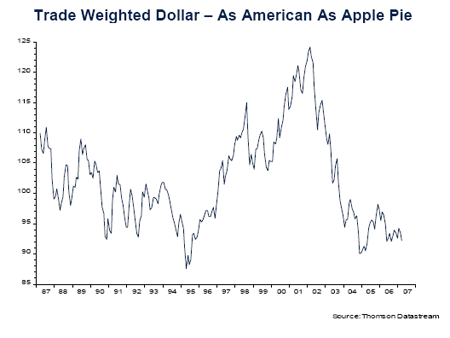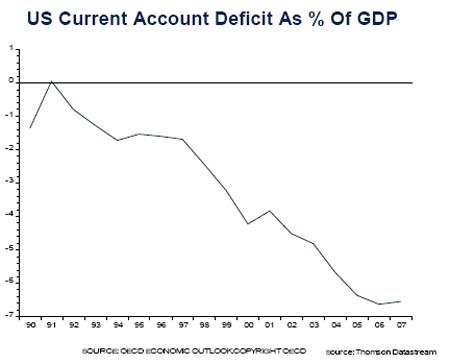Has the Dollar met its date with destiny?
Jeremy Batstone is concerned by a dangerously complacent attitude towards the Dollar: just because it's always been strong doesn't mean it will stay that way. However, a decline wouldn't be all bad news.
To many observers a strong dollar has always been there, is something they have grown up with and that its continuing strength, no matter what happens, is nothing less than a fait a complis. We are concerned by what we sense is a dangerously complacent attitude (as revealed in the chart below) and, in the wake of the Federal Reserve's decision to adopt a de facto neutral bias to monetary policy, by what we see as a move which potentially triggers the dollar's date with destiny.

The dollar's steady decline on the foreign exchange markets which was interrupted, as the trade weighted chart (above) shows clearly, between 1995 - 2002, has been resumed over the past two years. Despite some mild improvement in the structural imbalances requiring the downtrend in the first place over the past few months, we believe that the US currency's descent seems certain to gather momentum again. This will have important long-term repercussions whilst creating short-term opportunities for investors along the way.
Dollar has become dependent on foreign capital
The basis for our position lies in the fact that the US has become (and is still, despite signs of Asian central bank reserve diversification) dependent on foreign capital and that that level of dependency is absolutely without historical precedent. All lending by overseas investors will eventually need to be paid back with actual goods (i.e. lenders eventually expect to get paid back). Beyond the need to eventually pay back the debt to foreigners, the US economy is essentially addicted to the flow of new borrowing from overseas investors. This borrowing has been necessary to sustain spending levels that remain significantly in excess of earnings levels. Without this borrowing consumption would inevitably collapse. The US trade balance (see chart below) is not just slightly out of kilter the US now imports nearly twice as many goods as it exports, and is financing the difference via borrowing. This borrowing has increased because the gap is widening.
Subscribe to MoneyWeek
Subscribe to MoneyWeek today and get your first six magazine issues absolutely FREE

Sign up to Money Morning
Don't miss the latest investment and personal finances news, market analysis, plus money-saving tips with our free twice-daily newsletter
Don't miss the latest investment and personal finances news, market analysis, plus money-saving tips with our free twice-daily newsletter

The finances of countries work in a similar way to those of companies or individuals i.e. one cannot indefinitely sustain one's living standards on borrowed money because lenders don't want simply to increase their lending; they expect to get their money back, with a profit. They expect to sell financial investments and convert them into goods and services. So, the US is, essentially, borrowing goods and services and lenders are expecting to be paid back in goods and services. The major difference between countries on the one hand and companies and individuals on the other, is that countries can manufacture the money with which they pay back their debt.
The reality is that when overseas investors ask to be paid back, it is unlikely that the US will be willing / able to pay them and will instead chose to devalue its currency rather than pay back the debts that have mounted up. Once overseas investors recognise that the US cannot and will not pay back its debt without a significant devaluation (essentially a write-down of debts since they are dollar-denominated), the race to the exit will begin. That this is bearish for the dollar goes without saying. In our view, the process by which overseas capital repatriates (Asian central banks are already seeking to diversify their exposure to US Treasuries) may prove fairly gradual at first, the long-term implications masked by the relatively small size of such initial adjustments, but much more acute later.
Dollar slump will hit wider markets
This is not just a problem for the dollar because declining overseas demand for US assets is certain to ripple through all US financial markets and impact all those trading US assets. The "silent hero" of the US economic miracle of the late 1990's was the tidal wave of overseas capital into the country. Overseas' investors desire to throw money at the US proved a key catalyst for the most massive private borrowing spree the country had ever seen. So much so that the US economy and financial markets are inextricably linked to overseas investors' faith in the US economic model. Staggeringly, the US continues to absorb around 80% of net free world capital and two things are for sure; firstly, the upside is capped at 100% and secondly, that that level must eventually fall back as there must be a limit as to the willingness of overseas investors to buy any and all US capital.
If the Federal Reserve has, by its apparent action to move to a de facto neutral bias to monetary policy setting, begun the process of global monetary easing it is well ahead of its global counterparts. The Bank of Japan is being precluded from moving Japanese base rates higher by overt political intervention. The People's Bank of China continues to push rates higher to curb an economy that continues to overheat. The European Central Bank seems certain to continue its now prolonged period of monetary tightening as that region's economic performance continues to improve while underlying inflationary pressure remains stubbornly high and the Bank of England seems set to push domestic base rates a further notch higher in response to ongoing fears regarding incipient inflationary pressure.
Dollar fall would not be all bad
The view that a fall in the dollar is, universally, a bad thing is misplaced in our view. Whilst a dollar slide is potentially apocalyptic for that country it is not to be compared with the global consequences of a slump in US equity or bond prices. A plunge in the US dollar means, of course, that other currencies are rising against it. At the global level the positives and negatives might cancel each other out (although there will be some relative winners and losers), this should provide plenty of food for thought for yen carry traders. Note, too, that dollar weakness may help to reduce those global structural imbalances and possibly cushion the US economy from a domestic-led downturn (exports become cheaper) although we are not convinced about the US ability to export its way out of a slowdown. There is, clearly, a difficult time ahead for the engine of global economic activity, even if other regions continue to grow strongly. This should give asset allocators plenty to ponder but vindicates our long-term strategic enthusiasm for Asia.
Whilst it is impossible to know when overseas investors (Asian central banks) will chose to stop lending to the US and start demanding payment, over time it will happen. When this comes, it is very unlikely that the US will have any option but to pay back with significantly devalued dollars because the US is extremely unlikely to part with the 27% of GDP deemed necessary to pay back the debt. One day holders of US assets worldwide will wake up to this reality. We continue to regard the insouciance on the part of the markets to this position as potentially complacent. Further dollar weakness is inevitable.
By Jeremy Batstone, Director of Private Client Research at Charles Stanley
-
 Meta’s AI splurge rattles investors
Meta’s AI splurge rattles investorsMeta's decision to join the AI race is driving investors away
By Dr Matthew Partridge Published
-
 Is it a good time to invest in the UK?
Is it a good time to invest in the UK?Temple Bar Investment Trust is a diversified bet on British equities and looks excellent value, says Max King
By Max King Published